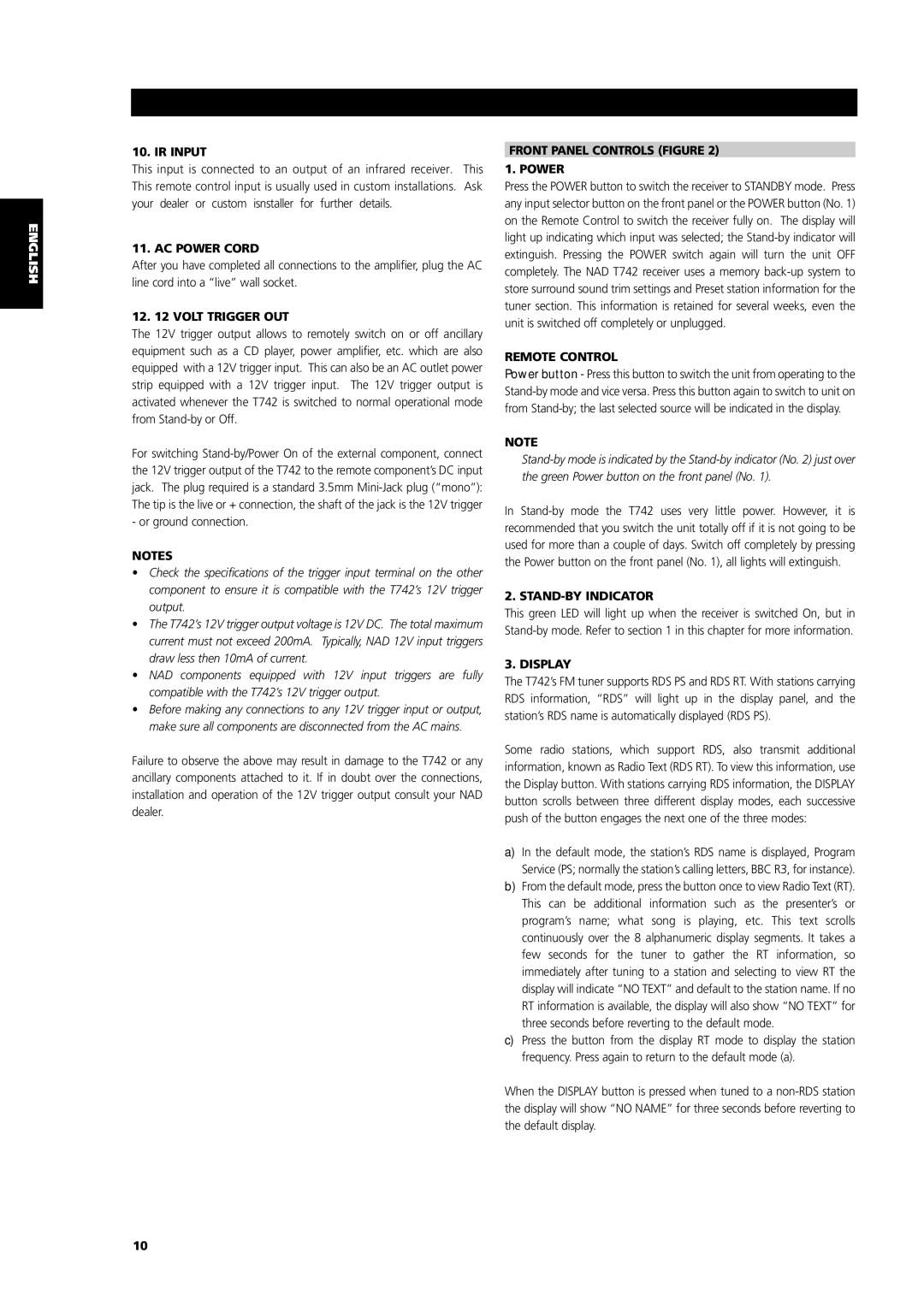
ENGLISH FRANÇAIS DEUTSCH NEDERLANDS ESPAÑOL ITALIANO PORTUGUÊS SVENSKA
10.IR INPUT
This input is connected to an output of an infrared receiver. This This remote control input is usually used in custom installations. Ask your dealer or custom isnstaller for further details.
11. AC POWER CORD
After you have completed all connections to the amplifier, plug the AC line cord into a “live” wall socket.
12. 12 VOLT TRIGGER OUT
The 12V trigger output allows to remotely switch on or off ancillary equipment such as a CD player, power amplifier, etc. which are also equipped with a 12V trigger input. This can also be an AC outlet power strip equipped with a 12V trigger input. The 12V trigger output is activated whenever the T742 is switched to normal operational mode from
For switching
NOTES
•Check the specifications of the trigger input terminal on the other component to ensure it is compatible with the T742’s 12V trigger output.
•The T742’s 12V trigger output voltage is 12V DC. The total maximum current must not exceed 200mA. Typically, NAD 12V input triggers draw less then 10mA of current.
•NAD components equipped with 12V input triggers are fully compatible with the T742’s 12V trigger output.
•Before making any connections to any 12V trigger input or output, make sure all components are disconnected from the AC mains.
Failure to observe the above may result in damage to the T742 or any ancillary components attached to it. If in doubt over the connections, installation and operation of the 12V trigger output consult your NAD dealer.
FRONT PANEL CONTROLS (FIGURE 2)
1. POWER
Press the POWER button to switch the receiver to STANDBY mode. Press any input selector button on the front panel or the POWER button (No. 1) on the Remote Control to switch the receiver fully on. The display will light up indicating which input was selected; the
REMOTE CONTROL
Power button - Press this button to switch the unit from operating to the
NOTE
In
2. STAND-BY INDICATOR
This green LED will light up when the receiver is switched On, but in
3. DISPLAY
The T742’s FM tuner supports RDS PS and RDS RT. With stations carrying RDS information, “RDS” will light up in the display panel, and the station’s RDS name is automatically displayed (RDS PS).
Some radio stations, which support RDS, also transmit additional information, known as Radio Text (RDS RT). To view this information, use the Display button. With stations carrying RDS information, the DISPLAY button scrolls between three different display modes, each successive push of the button engages the next one of the three modes:
a)In the default mode, the station’s RDS name is displayed, Program Service (PS; normally the station’s calling letters, BBC R3, for instance).
b)From the default mode, press the button once to view Radio Text (RT). This can be additional information such as the presenter’s or program’s name; what song is playing, etc. This text scrolls continuously over the 8 alphanumeric display segments. It takes a few seconds for the tuner to gather the RT information, so immediately after tuning to a station and selecting to view RT the display will indicate “NO TEXT” and default to the station name. If no RT information is available, the display will also show “NO TEXT” for three seconds before reverting to the default mode.
c)Press the button from the display RT mode to display the station frequency. Press again to return to the default mode (a).
When the DISPLAY button is pressed when tuned to a
10
